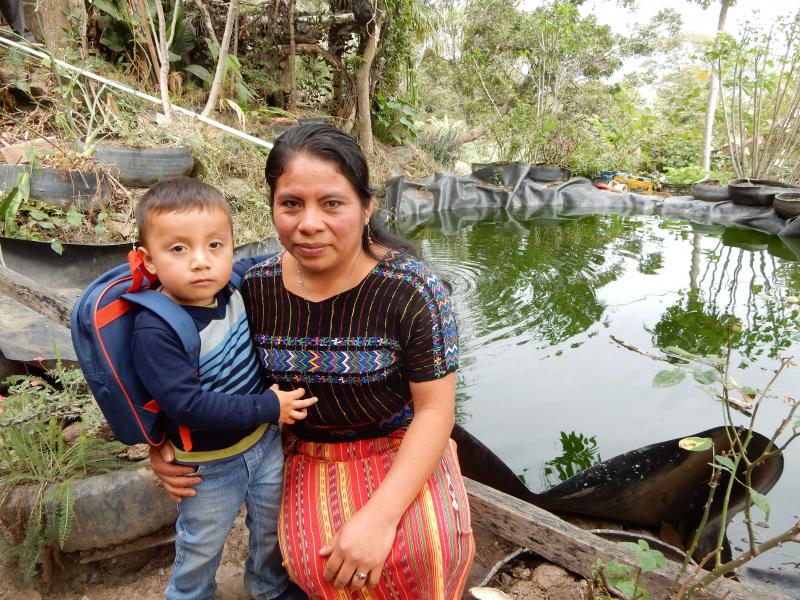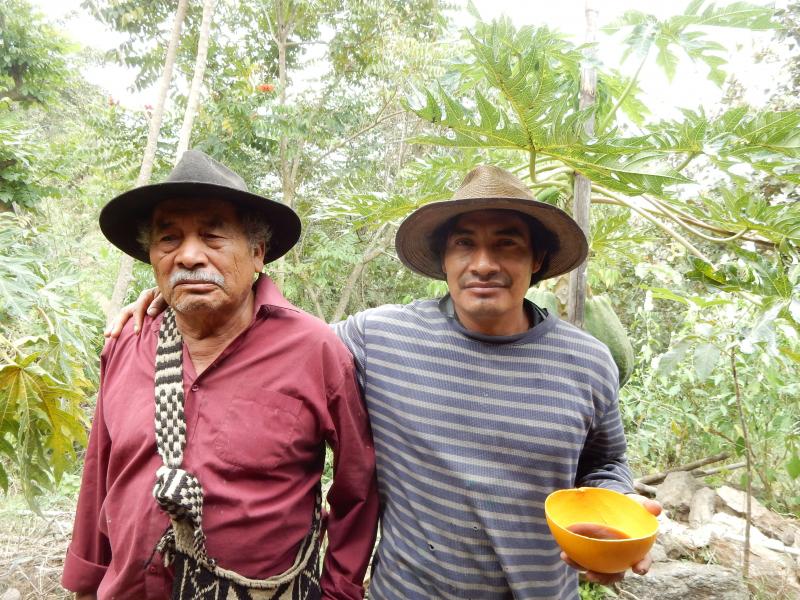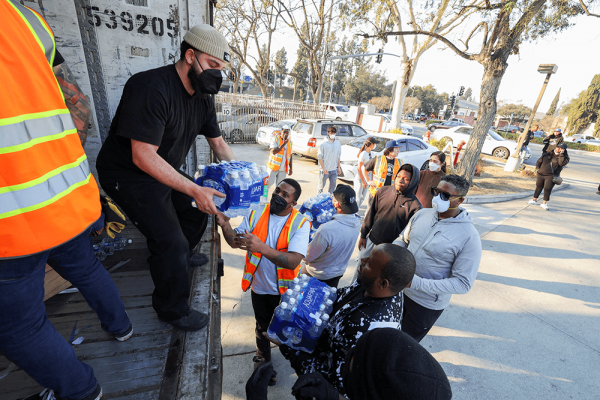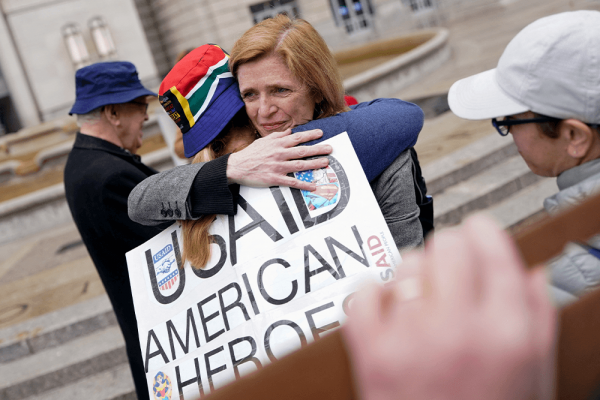RABINAL, BAJA VERAPAZ, GUATEMALA – The massive, white Catholic Cathedral of Rabinal, commissioned by Dominican friar Bartolomé de las Casas, who arrived in Guatemala's central highlands in 1537, still towers over the town in Guatemala's Baja Verapaz department. Las Casas was there to spread the word of God without the violent tactics employed elsewhere in the Spanish Conquista.
Nearly five centuries later, Indigenous faith communities are building their own peace in this same area, as a group of Indigenous women attempt to shape a healthier future through eco-friendly agriculture, while helping heal the wounds of Guatemala’s 1980s genocide. Their approach could serve as a model for the region.
In the dry corridor
Since the 1980s, conflict and food insecurity has continued to wrack the central highlands of Guatemala. They are part of the “dry corridor” that runs through Central America, making them historically vulnerable to drought. The highlands are also the heartland of the Maya Achí people, who have inhabited the region since antiquity.
But in the Maya Achí community of Xesiguan, about 7 miles outside of the town of Rabinal, the rocky soils and dry landscapes seem to drop away suddenly on the site of a farm that serves as an example to other farmers throughout the region.
Blecin Rublia-Cajuj, 31, one of the key figures in this community founded by catechists, showed me the various parts of the farm: the small pond that holds Tilapia fish and snails; the chicken coop; the coffee bushes; a wide variety of legumes, fruits, and vegetables. This was all while we chewed on freshly cut sugar cane, trailed by her son, 3-year-old Ulices.
She explains that in this dry region, having food security is critical and allows them to expand into other activities.
“We are in the process of buying a corn mill, so that we can make chicken feed – we can get a better price for our chickens if they are fed well,” she said. “I am also a member of a collective that sells handmade bags and other textiles to the U.S.”
guatemala_blecin_son_1.jpg

Xesiguan is just one of the many Maya Achí communities that faced vicious attacks in 36-year conflict that has been estimated to have left 200,000 people killed or disappeared. There were five confirmed massacres of the inhabitants of the nearby Rio Negro community where 444 of about 800 original residents were killed between 1980 and 1982.
Securing forests and food security
According to Alfedo Cortez, the owner of the farm, his plot serves as a model for the Association of Community Production Committees (ACPC) that brings together about 150 families from various communities in Rabinal: Xesiguán, San Luis, Chixim, Concúl, among others. Here, farmers can learn about incorporating agro-ecological principles into farming practices, a trend catching on across Latin America. These techniques include rotational cropping, agroforestry, integrated crop and livestock systems, and the use of local varieties.
guatemala_father_and_son_leaders_1.jpg

Both the department of Baja Verapaz and Guatemala’s national Ministry of Agriculture have visited and been impressed by how, with these techniques, the communities are more resilient during times of drought.
Alvaro Fernandez-Llamazares is an ethno-ecologist at the Helsinki Institute of Sustainability Science (HELSUS), who has conducted fieldwork in Indigenous communities in Bolivia, Costa Rica, Kenya, and Madagascar. He says that there is a substantial amount of literature that has shown how traditional Indigenous agriculture contributes to biodiversity conservation and sustainability in multiple ways.
“Traditional management practices can help to increase landscape biodiversity through the creation of habitat mosaics or to conserve crop diversity,” he said. “Similarly, many Indigenous communities are limiting local levels of nitrogen pollution through a minimal use of chemical pesticides or fertilizers.”
“There is increasing concern that a shift from a logic of subsistence to one of commercial-based agriculture could impact the sustainability of some of these practices,” Fernandez-Llamazares told me. “But the impacts of subsistence-based agriculture are still quite marginal when compared to the ones posed by the enormous agro-business operations and large-scale mono-cropping plantations.”
According to Rublia-Cajuj and Cortez, the Maya Achí have land titles over their farms perhaps because the land was once rocky and remote, meaning there wasn’t as much encroachment and dispossession as other parts of Latin America.
Fernandez-Llamazares says there are dozens of studies showing that land tenure insecurity is one of the main underlying drivers of forest loss in much of the planet.
“The rise of Indigenous-led conservation models, rooted in Indigenous knowledge systems and designed in accordance with Indigenous peoples’ rights and law, holds promise in reshaping the ways in which conservation practice is implemented,” Fernandez-Llamazares said.
Changing roles
One of the unique elements of the ACPC is that they have a women’s council, of which Rublia-Cajuj is a part. As we walk through the farm, she explains that women are now taking leadership roles on top of their household responsibilities.
“Before, there was a lot of machismo and women didn’t even go to school,” Rublia-Cajuj said.
Grahame Russell, co-director of Rights Action, which he has helped run since 1995 – and who works with communities across Guatemala to fight for their human and economic rights – says that women’s empowerment in the region is complex and deeply linked to the civil conflict.
He explained that most of the trends of gender discrimination that you find in the central highlands are present in many other places in Latin America and the world, but Rabinal has its own dynamic of how women’s empowerment is happening.
“Resistance to the U.S.-backed repression of the 1970s and 1980s was community-based, meaning the whole community is involved,” he said. “Communities will follow natural leaders and in many communities, the powerful, articulate person was a woman, or a number of women, who became community leaders.”
But Russell says there was another factor as well: In the early years of the conflict, men and older boys were the main targets of the army and government-backed armed groups.
“Women took on natural leadership roles because the husbands and older boys had been killed.”
Meanwhile, back on the model farm in Xesiguán, Cortez is blunt about both the past and the future and stressed the role of food security. He was five years old when the massacres were happening.
“If we can’t eat properly, we can’t be visionaries,” he said.
Got something to say about what you're reading? We value your feedback!







